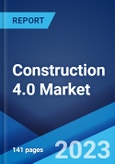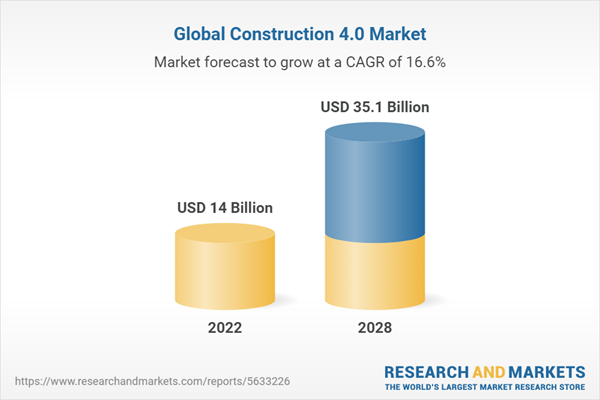The global construction 4.0 market size reached US$ 14.0 Billion in 2022. Looking forward, the publisher expects the market to reach US$ 35.1 Billion by 2028, exhibiting a growth rate (CAGR) of 15.7% during 2023-2028.
Construction 4.0 is a subset of industry 4.0 comprising interconnected technologies that digitize, automate and integrate the construction process throughout the value chain. It relies on the internet of things (IoT), digital twin, additive manufacturing, cloud computing, cyber-physical systems (CPS), and building information modeling (BIM). It helps lower energy use, develop 3D models that avoid inefficiencies and delays in projects, and reduce waste materials and carbon emissions during construction. It also minimizes security risks of workers through augmented reality (AR) and virtual reality (VR) solutions.
2. What is the expected growth rate of the global construction 4.0 market during 2023-2028?
3. What has been the impact of COVID-19 on the global construction 4.0 market?
4. What are the key factors driving the global construction 4.0 market?
5. What is the breakup of the global construction 4.0 market based on the solution?
6. What is the breakup of the global construction 4.0 market based on the technology?
7. What is the breakup of the global construction 4.0 market based on the application?
8. What is the breakup of the global construction 4.0 market based on the end user?
9. What are the key regions in the global construction 4.0 market?
10. Who are the key players/companies in the global construction 4.0 market?
Construction 4.0 is a subset of industry 4.0 comprising interconnected technologies that digitize, automate and integrate the construction process throughout the value chain. It relies on the internet of things (IoT), digital twin, additive manufacturing, cloud computing, cyber-physical systems (CPS), and building information modeling (BIM). It helps lower energy use, develop 3D models that avoid inefficiencies and delays in projects, and reduce waste materials and carbon emissions during construction. It also minimizes security risks of workers through augmented reality (AR) and virtual reality (VR) solutions.
Construction 4.0 Market Trends:
At present, there is a rise in the utilization of artificial intelligence (AI) in the construction industry across the globe. This, along with the escalating need for new technologies in bricklaying, plastering, surveying, site and risk management, and worker and asset tracking, represents one of the key factors driving the market. Moreover, construction drones are used for security, inspection and monitoring of construction activities around the world. In addition, waste optimization and proper time and resource management in the construction industry are propelling the growth of the market. Besides this, the growing adoption of industrial 4.0 technologies in construction activities to enhance remote monitoring and avoid human errors, are contributing to the growth of the market. Additionally, there is an increase in the construction of new roads and highways, especially in developing nations, which is offering lucrative growth opportunities to industry investors and end-users. Other growth-inducing factors are rapid digitization and the rising urban population worldwide. Furthermore, key market players are focusing on partnerships, acquisitions, and product launches to improve products and services, which is projected to strengthen the growth of the market.Key Market Segmentation:
The publisher provides an analysis of the key trends in each sub-segment of the global construction 4.0 market report, along with forecasts at the global, regional and country level from 2023-2028. The report has categorized the market based on solution, technology, application and end user.Breakup by Solution:
- Hardware
- Software
- Services
Breakup by Technology:
- IoT
- Artificial Intelligence
- Industrial Robots
- Others
Breakup by Application:
- Asset Monitoring
- Predictive Maintenance
- Fleet Management
- Wearables
- Others
Breakup by End User:
- Residential
- Non-residential
Breakup by Region:
- North America
- United States
- Canada
- Asia-Pacific
- China
- Japan
- India
- South Korea
- Australia
- Indonesia
- Others
- Europe
- Germany
- France
- United Kingdom
- Italy
- Spain
- Russia
- Others
- Latin America
- Brazil
- Mexico
- Others
- Middle East and Africa
Competitive Landscape:
The competitive landscape of the industry has also been examined along with the profiles of the key players being ABB Ltd., Autodesk Inc, Brickeye, CalAmp Corp., Hexagon AB, Hilti Corporation, Mitsubishi Electric Corporation, Oracle Corporation, Topcon Corporation and Trimble Inc.Key Questions Answered in This Report
1. What was the size of the global construction 4.0 market in 2022?2. What is the expected growth rate of the global construction 4.0 market during 2023-2028?
3. What has been the impact of COVID-19 on the global construction 4.0 market?
4. What are the key factors driving the global construction 4.0 market?
5. What is the breakup of the global construction 4.0 market based on the solution?
6. What is the breakup of the global construction 4.0 market based on the technology?
7. What is the breakup of the global construction 4.0 market based on the application?
8. What is the breakup of the global construction 4.0 market based on the end user?
9. What are the key regions in the global construction 4.0 market?
10. Who are the key players/companies in the global construction 4.0 market?
Table of Contents
1 Preface3 Executive Summary12 Value Chain Analysis14 Price Analysis
2 Scope and Methodology
4 Introduction
5 Global Construction 4.0 Market
6 Market Breakup by Solution
7 Market Breakup by Technology
8 Market Breakup by Application
9 Market Breakup by End User
10 Market Breakup by Region
11 SWOT Analysis
13 Porters Five Forces Analysis
15 Competitive Landscape
Companies Mentioned
- ABB Ltd.
- Autodesk Inc
- Brickeye
- CalAmp Corp.
- Hexagon AB
- Hilti Corporation
- Mitsubishi Electric Corporation
- Oracle Corporation
- Topcon Corporation
- Trimble Inc.
Methodology

LOADING...
Table Information
| Report Attribute | Details |
|---|---|
| No. of Pages | 141 |
| Published | September 2023 |
| Forecast Period | 2022 - 2028 |
| Estimated Market Value ( USD | $ 14 Billion |
| Forecasted Market Value ( USD | $ 35.1 Billion |
| Compound Annual Growth Rate | 16.6% |
| Regions Covered | Global |
| No. of Companies Mentioned | 10 |









